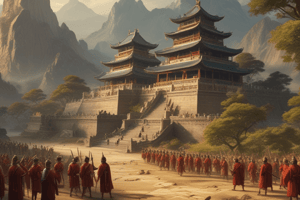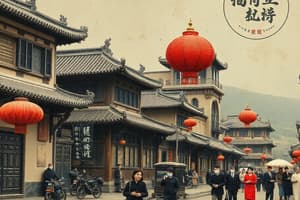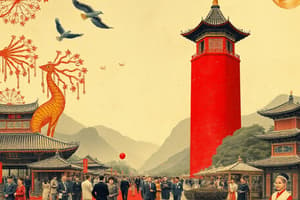Podcast
Questions and Answers
Which dynasty is known for unifying China for the first time?
Which dynasty is known for unifying China for the first time?
- Qin Dynasty (correct)
- Han Dynasty
- Tang Dynasty
- Xia Dynasty
Who is recognized as the first emperor in Chinese history?
Who is recognized as the first emperor in Chinese history?
- Han Wudi
- Emperor Taizong
- Sun Yat Sen
- Qin Shi Huang (correct)
Which dynasty saw the first appearance of banknotes in China?
Which dynasty saw the first appearance of banknotes in China?
- Tang Dynasty
- Ming Dynasty
- Qing Dynasty
- Song Dynasty (correct)
What event is Lin Zexu most well-known for?
What event is Lin Zexu most well-known for?
What is the area of China's territory?
What is the area of China's territory?
Who was the chief designer of China's reform and opening-up?
Who was the chief designer of China's reform and opening-up?
Which year marks the establishment of the Republic of China?
Which year marks the establishment of the Republic of China?
What is the highest organ of state power in China?
What is the highest organ of state power in China?
What does the Chinese character 福 signify?
What does the Chinese character 福 signify?
When does the Lantern Festival occur in the lunar calendar?
When does the Lantern Festival occur in the lunar calendar?
Which festival is known as the Old People Festival?
Which festival is known as the Old People Festival?
What is commemorated during the Dragon Boat Festival?
What is commemorated during the Dragon Boat Festival?
Which of the following classical novels is authored by Wu Cheng'en?
Which of the following classical novels is authored by Wu Cheng'en?
What aspect of the characters in Dream of the Red Chamber primarily reflects?
What aspect of the characters in Dream of the Red Chamber primarily reflects?
During which festival do family members typically gather to admire the moon?
During which festival do family members typically gather to admire the moon?
Which color in Peking Opera's facial make-up represents integrity and courage?
Which color in Peking Opera's facial make-up represents integrity and courage?
What was a significant outcome of the May 4th New Culture Movement?
What was a significant outcome of the May 4th New Culture Movement?
Who is the author of the first vernacular novel in modern Chinese literature?
Who is the author of the first vernacular novel in modern Chinese literature?
Which of the following correctly associates the character with their respective novel?
Which of the following correctly associates the character with their respective novel?
What represents an irritable character in Peking Opera's facial make-up?
What represents an irritable character in Peking Opera's facial make-up?
Which dynasty is known for reaching the peak of Chinese industry?
Which dynasty is known for reaching the peak of Chinese industry?
Which river is known as the mother river of the Chinese nation?
Which river is known as the mother river of the Chinese nation?
What is the main food staple in northern China?
What is the main food staple in northern China?
Which cuisine is known for hot-pot and Mapo doufu?
Which cuisine is known for hot-pot and Mapo doufu?
Where can the Terracotta Army be found?
Where can the Terracotta Army be found?
Which work is considered the longest lyrical poem in Chinese classical literature?
Which work is considered the longest lyrical poem in Chinese classical literature?
What is Wuyue commonly referred to?
What is Wuyue commonly referred to?
Which mountain served as the holy mountain worshipped by the people?
Which mountain served as the holy mountain worshipped by the people?
Which of the following foods is typically eaten during the Dragon Boat Festival?
Which of the following foods is typically eaten during the Dragon Boat Festival?
What year was China's policy of 'reform and opening-up' put forward?
What year was China's policy of 'reform and opening-up' put forward?
Who is recognized as the 'Father of Hybrid Rice'?
Who is recognized as the 'Father of Hybrid Rice'?
What significant event for the Chinese economy occurred in 1980?
What significant event for the Chinese economy occurred in 1980?
Which statement best describes the 'Western Development Strategy'?
Which statement best describes the 'Western Development Strategy'?
What is the 'mother industry' of human beings?
What is the 'mother industry' of human beings?
When did China complete the 'Poverty Alleviation Plan'?
When did China complete the 'Poverty Alleviation Plan'?
In what year did China join the WTO?
In what year did China join the WTO?
Which dynasty is considered the richest in Chinese history?
Which dynasty is considered the richest in Chinese history?
Who invented the first movable type printing and in which dynasty did this occur?
Who invented the first movable type printing and in which dynasty did this occur?
What is the name of the proper compass developed during the Song dynasty?
What is the name of the proper compass developed during the Song dynasty?
What were Chinese alchemists attempting to create when they discovered huǒyào?
What were Chinese alchemists attempting to create when they discovered huǒyào?
Who is known as the 'Father of Two Bombs and One Star'?
Who is known as the 'Father of Two Bombs and One Star'?
In what year did China successfully launch its first Earth artificial satellite?
In what year did China successfully launch its first Earth artificial satellite?
What is the top speed reached by Fuxing trains?
What is the top speed reached by Fuxing trains?
What are considered the New Four Great Inventions in China?
What are considered the New Four Great Inventions in China?
Who was the first person from China to fly into space?
Who was the first person from China to fly into space?
Flashcards
Which dynasty is the first in Chinese history?
Which dynasty is the first in Chinese history?
The Xia Dynasty, which existed from approximately 2070 to 1600 BCE, is considered the first dynasty in Chinese history. Though its existence is debated by historians, it marks a crucial period in the development of Chinese civilization.
Which dynasty unified China for the first time?
Which dynasty unified China for the first time?
The Qin dynasty, which ruled from 221 to 206 BCE, is known for unifying all of China for the first time. This unification laid the groundwork for a strong and centralized empire, setting the stage for later dynasties.
Who is the first emperor in Chinese history?
Who is the first emperor in Chinese history?
Qin Shi Huang, the first emperor of the Qin dynasty, was a pivotal figure in Chinese history. He unified China, standardized writing, and initiated the construction of the Great Wall, leaving a lasting legacy on Chinese culture and governance.
From which dynasty are Chinese people known as "Han people"?
From which dynasty are Chinese people known as "Han people"?
Signup and view all the flashcards
Which dynasty is famous for its prosperity during the period of Taizong and Xuanzong?
Which dynasty is famous for its prosperity during the period of Taizong and Xuanzong?
Signup and view all the flashcards
In which dynasty did banknotes first appear?
In which dynasty did banknotes first appear?
Signup and view all the flashcards
What is the last Imperial Dynasty of China?
What is the last Imperial Dynasty of China?
Signup and view all the flashcards
In what year was the First Opium War?
In what year was the First Opium War?
Signup and view all the flashcards
Mount Everest
Mount Everest
Signup and view all the flashcards
Qinling Mountain
Qinling Mountain
Signup and view all the flashcards
Yangtze River
Yangtze River
Signup and view all the flashcards
Qu Yuan
Qu Yuan
Signup and view all the flashcards
The Analects
The Analects
Signup and view all the flashcards
The Moon
The Moon
Signup and view all the flashcards
Dumplings
Dumplings
Signup and view all the flashcards
Shandong Cuisine
Shandong Cuisine
Signup and view all the flashcards
Which dynasty saw the peak of Chinese industry?
Which dynasty saw the peak of Chinese industry?
Signup and view all the flashcards
What was the economic form of ancient Chinese agriculture?
What was the economic form of ancient Chinese agriculture?
Signup and view all the flashcards
When was silk first exported to Europe?
When was silk first exported to Europe?
Signup and view all the flashcards
In traditional Chinese music, what does "丝与竹" refer to?
In traditional Chinese music, what does "丝与竹" refer to?
Signup and view all the flashcards
In Peking Opera, what do different face colors symbolize?
In Peking Opera, what do different face colors symbolize?
Signup and view all the flashcards
What are the five notes of the Pentatonic scale in traditional Chinese music?
What are the five notes of the Pentatonic scale in traditional Chinese music?
Signup and view all the flashcards
What is the 'Mother of China's operas'?
What is the 'Mother of China's operas'?
Signup and view all the flashcards
What is China's 'national opera'?
What is China's 'national opera'?
Signup and view all the flashcards
What is the Chinese Zodiac?
What is the Chinese Zodiac?
Signup and view all the flashcards
When is the Chinese New Year?
When is the Chinese New Year?
Signup and view all the flashcards
What does the Chinese character "福" mean?
What does the Chinese character "福" mean?
Signup and view all the flashcards
When is the Lantern Festival?
When is the Lantern Festival?
Signup and view all the flashcards
What is the Qingming Festival?
What is the Qingming Festival?
Signup and view all the flashcards
Who invented papermaking?
Who invented papermaking?
Signup and view all the flashcards
Who invented movable type printing?
Who invented movable type printing?
Signup and view all the flashcards
What was the name of the simple compass used during the Warring States period?
What was the name of the simple compass used during the Warring States period?
Signup and view all the flashcards
What was the name of the compass invented in the Song Dynasty?
What was the name of the compass invented in the Song Dynasty?
Signup and view all the flashcards
How was gunpowder discovered?
How was gunpowder discovered?
Signup and view all the flashcards
What was gunpowder's first use in the Tang Dynasty?
What was gunpowder's first use in the Tang Dynasty?
Signup and view all the flashcards
When was gunpowder introduced to the Arab regions?
When was gunpowder introduced to the Arab regions?
Signup and view all the flashcards
Who invented the first seismograph?
Who invented the first seismograph?
Signup and view all the flashcards
What was the Silk Road?
What was the Silk Road?
Signup and view all the flashcards
When was the PRC founded?
When was the PRC founded?
Signup and view all the flashcards
Who is known as the 'Father of Reform and Opening-up'?
Who is known as the 'Father of Reform and Opening-up'?
Signup and view all the flashcards
When did the 'Reform and Opening-up' policy start?
When did the 'Reform and Opening-up' policy start?
Signup and view all the flashcards
Where were the first internal reforms of China's 'Reform and Opening-up' implemented?
Where were the first internal reforms of China's 'Reform and Opening-up' implemented?
Signup and view all the flashcards
What was the first step of China's opening to the world?
What was the first step of China's opening to the world?
Signup and view all the flashcards
What is the 'Western Development Strategy'?
What is the 'Western Development Strategy'?
Signup and view all the flashcards
What are the components of the 'Belt and Road Initiative'?
What are the components of the 'Belt and Road Initiative'?
Signup and view all the flashcards
Study Notes
Ancient Chinese History
- Ancestors of the Chinese people: Huangdi and Yandi
- First dynasty: Xia Dynasty
- Dynasty that unified China: Qin Dynasty
- First emperor of China: Qin Shi Huang
- Chinese people known as "Han people" from: Han Dynasty
- Origin of Silk Road: Han Dynasty
- Tang dynasty prosperity: from Emperor Taizong to Emperor Xuanzong or Guancheng and kaiyuan
- Earliest banknotes: Song Dynasty (Jiaozi)
- Seven voyages to Western Oceans: Zheng He during the Ming Dynasty
- Last dynasty: Qing Dynasty
Modern and Contemporary Chinese History
- Opium destruction: Lin Zexu, in Humen, Guangdong
- First Opium War: 1839
- Burned Garden: Yuan Ming Yuan
- Chinese Revolutionary Democrats leader: Sun Yat Sen
- Xinhai Revolution year: 1911
Chinese Geography
- China's full name: The People's Republic of China (PRC)
- China's territory: 9.6 million square kilometers
- Administrative divisions: 34 (23 provinces, 5 autonomous regions, 4 municipalities, 2 special administrative regions)
- Capital: Beijing
- Economic center: Shanghai
- Ancient capital of 13 imperial dynasties: Xi'an
- Ethnic groups: 56 (55 minorities, Han largest)
Science & Technology Development in China
- Four Great Inventions: Papermaking, Printing (Movable Type Printing), Compass, Gunpowder
- Improved papermaking: Cai Lun, Han Dynasty
- Movable Type printing: Bi Sheng, Song Dynasty
- Compass: Warring States period
Chinese Cuisine
- Main foods (South/North): rice (south), wheat-based dishes (north)
- Spring Festival foods: dumplings (jiaozi), spring rolls
- Eight cuisines: Sichuan, Guangdong, Shandong, Jiangsu, Fujian, Zhejiang, Hunan, Anhui
- Oldest cuisine: Shandong/Lu Cuisine
- Hot pot/Mapo doufu cuisine: Sichuan Cuisine/ Chuan Cai Cuisine
- Dragon Boat Festival food: Zongzi
- Mid-Autumn Festival food: Mooncakes
- Solar terms: 24
- Winter Solstice food: Dumplings
Chinese Culture
- Confucius: started private schools in China
- Kong Zi: proposed education for all without discrimination
- Four Great Academies: not specified in the text
Chinese History
- People's Republic of China established: October 1, 1949
- Chinese Reform and Opening-up policy: Deng Xiaoping, 1978
- Special Economic Zones (SEZs): Shenzhen, 1980
- China joins WTO: 2001
- Five-Year Plans: Started from 1953, 14 completed
- Socialist market economic system: October 1992
- "Mother industry": Agriculture
- Hybrid Rice father: Yuan Longping
- Poverty Alleviation Plan completion: November 23, 2020
- Core BDS-3 constellation system completion: 2020
Studying That Suits You
Use AI to generate personalized quizzes and flashcards to suit your learning preferences.




